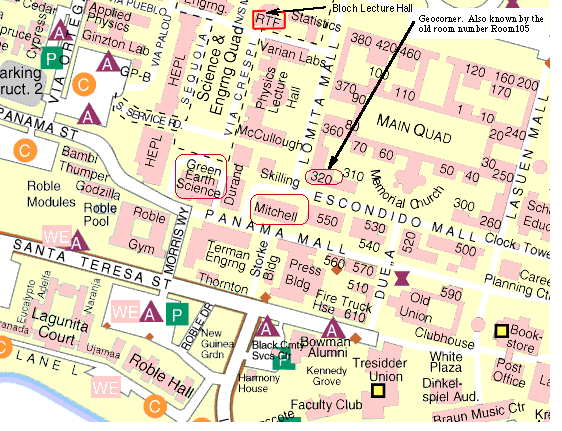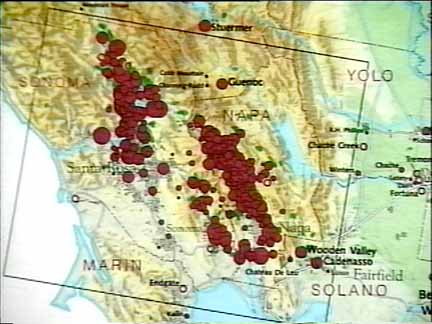
"What you're tasting in a bottle of wine is 100 million years of geologic history." That tantalizing idea is a recurrent theme of David Howell's presentation about the geology and wines of the Napa Valley, California. The Napa Valley, a small area (one-sixth the size of the Bordeaux region of France), is one of the USA's premier wine-producing regions, well known to wine lovers around the world.
It is no secret among students of wine that the qualities (and frequently the cost!) of the finished product reflect in a very complex way the winemaker's art, as well as the soil, topography, and climate where the grapes were grown. But soil, topography, and climate themselves are closely related to geologic factors: soil characteristics reflect the nature of the rocks from which the soils formed, rock types control or help to shape topography, and topography strongly influences local climate.
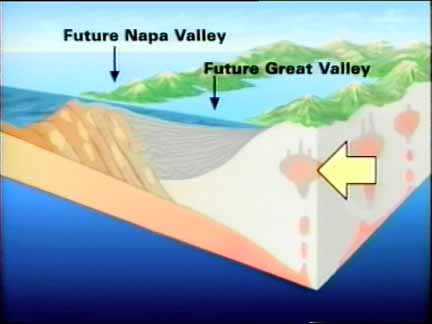
Geology plays an important role in controlling the quality and nuances of California's wine. It affects the soils-their chemistry and texture, the topography-mountain slopes versus valley floors, and the climate-humidity, sun angle, and temperature. The three S's-soil, slope, and sun, helps us understand the principal factors that control wine quality. How the vintner manipulates these controls determines the specific attributes of each bottle of wine. Understanding the geology of different California regions, and how it relates to wine growing, can be broken down into three basic categories: how the bedrock formed, evolution of the landscape, and relating these two factors to soil development and micro-climatic conditions
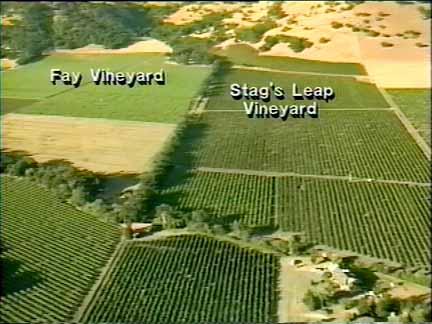
Critically important and also immensely fascinating is the human side of winemaking. Someone has to decide where to plant the vines, how best to nurture them, and when it is exactly the right moment to harvest the fruit; to recognize how the characteristics of the growing locality influence the qualities of the grapes and the character of the wines produced from them; and finally to decide how to manage the long, sometimes balky, and unpredictable process that transforms the grapes into wine. Thus, wine is art, crafted as much by human skill, experience, instinct, and intuition as by science.
About the Speaker
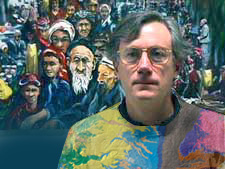
David G. Howell Received B.A. from Colgate University and a Ph.D. from Univ. California, Santa Barbara. Since joining the U.S. Geological Survey in 1974, his research has involved concepts for the growth and shaping of continents, world-wide distribution of oil and gas, societal impact of landslides and currently is organizing an international summit - "Crowding the Rim" - an alliance with the U.S. Geological Survey, the American Red Cross, Stanford University and the Circum Pacific Council. As a geologist he studies the composition, ages and processes that form the underpinnings of the Earth's surface, as an artist he strives to capture and record the beauty and essence of these same features.
This will be the 330th meeting since 1954.
see map
Anyone wishing to attend the lecture only is welcome at no cost.
Reservations: The preferred way to make reservations is simply to email Willie Lee at lee@usgs.gov, tell him you will attend, commit to pay, and bring your payment to the meeting. A check made to "PGS" is preferred.
If you want to pay in advance:
Stanford faculty and students: Please make dinner reservations by Friday, Friday, September 29. Contact Dr. Juhn Liou via his mailbox (and leave check), Geological and Environmental Sciences Office, Mitchell Bldg. (Rm. 138). Make checks out to "PGS."
All others, including faculty and students from other Bay Area universities and colleges and USGS: Please make dinner reservations by Friday, September 29. Contact Willie Lee, at USGS, MS-977, 345 Middlefield Rd., Menlo Park, CA 94025, phone 650-329-4781. Send check made out to "PGS" to Willie.
Dinner is $25.00. Includes wine (5:30 to 6:15 PM.), dinner (6:15-7:30 PM.), tax, and tip. Note: PGS does not make revenue on this price.

